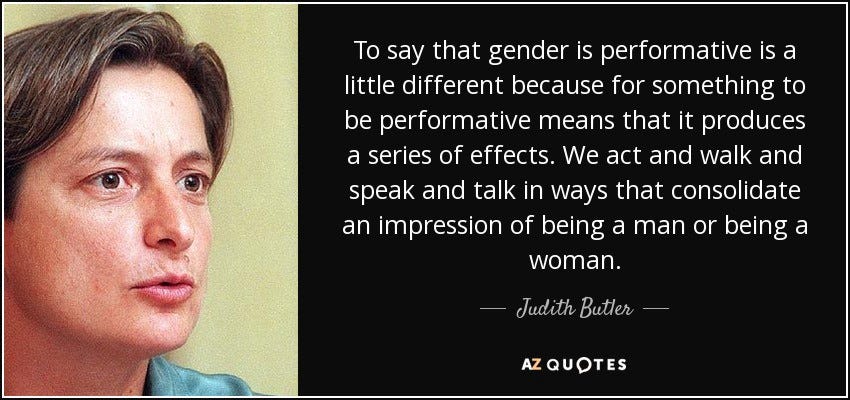By Maria-Nefeli Andredaki,
Dear reader, I am sure that the title you just read has possibly affected you in a certain way; made you curious or interested or even mad at what you think might follow in this article. This is exactly what one of my favourite professors said in class, before introducing us to the gender theory part of his course on culture studies, specifically regarding his own favourite gender theorist and philosopher- Judith Butler. Blurring the lines between a cult-figure and a highly-acclaimed academic, Butler is commonly known as that one professor whose lecture halls are so congested, to the point that people sit on window ledges, on each others’ laps, on the floor or as close to the door as humanly possible, in order to attend their lecture. It’s like queuing up for your favourite band’s concert, to paint a more accurate picture.
Butler’s most popular, and for some, most controversial work, is their book “Gender Trouble” which was inspired by their realization that whenever someone attempted to critically approach the concept of gender, they created trouble for themselves. In the book, the author argues that gender is a construction, a made-up concept that has been passed on from generation to generation, through the repetition of specific, stylized actions.
In order to delve deeper into Judith Butler’s take, we need to define and keep in mind specific terms that are central to their ideas and philosophy. First and foremost, Butler distances themselves from “essentialism”, the conviction that an identity is comprised of specific qualities and characteristics and no other quality or characteristic is allowed to be part of said identity. Furthermore, Butler refers to “compulsory heterosexuality”, the idea that there is a dominant heteronormative system which enforces heterosexuality on its people as the only acceptable sexuality, in order to control them. Another important term is, of course, the patriarchy, which refers to the hegemony of men and the exclusion of non-men.
So, what’s all this talk in modern culture about gender being fake? What does it mean to be gender-fluid or non-binary and how can these identities be justified through theory?

Well, let’s start off by saying that, for Butler, there is no single feminine experience or authentic masculine experience. That is because gender, the expression of how someone perceives themselves in regards to their biological sex, is actually completely disconnected from and has no base in their biology. There is no essential core to gender, no physical marker on the body that defines someone’s behavior as masculine or feminine.
A great example to support this claim is the color binary of blue for boys and pink for girls. There is no biological basis for this distinction, however, from an infant’s first moments in life, the people around them curate their environment with specifically colored clothes, toys, furniture, etc that supposedly align with their “gender”. To make it simpler, the social circle surrounding the infant proceeds to make specific choices, to act and interact in a certain way, that, to them, seems appropriate regarding the baby’s biological sex. However, as mentioned earlier, all of these are actions, choices and decisions, and not something innate that comes as part and parcel of the newborn’s biology. All of this shows that, in a way, the newborn’s gendered identity is acquired by the actions happening in their environment, by how others perceive them and how they teach them to perceive themselves.
Butler argues that the repeated actions and behaviors that are taught, learned and passed on are consolidated through the centuries and are employed by patriarchal systems to categorize and control the masses. This leads to people abiding by rigid stereotypes, in fear of being seen as “other”, as strange, deviant or even repulsive, which is absurd, considering the “performance” aspect; our utterances, acts and gestures are unconscious performances, the result of constant repetition which is attributed to something of no ontological status.
Taking all of this into account, the common argument of the gender binary completely shatters. Anyone, no matter their biological sex or physical state, is able and should be free to express themselves through their behavior, appearance, utterances and movement, without having to fit into stereotypes that plague close-minded people’s views of how things “should” be. Gender, as a performance, is infinite, non-restrictive and should ultimately not define our perception of another human being or be used as a tool for categorization.
And as far as pronouns are concerned, it never hurts to ask, does it?
References
- The editor’s personal notes on Judith Butler’s “Gender Trouble”




